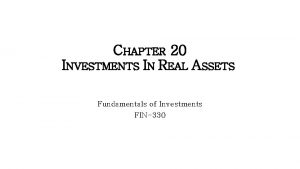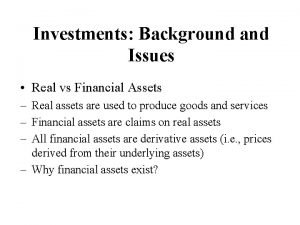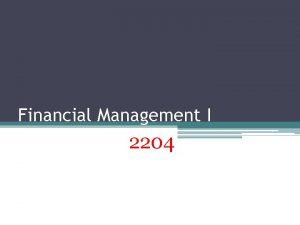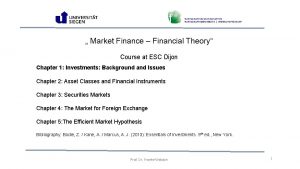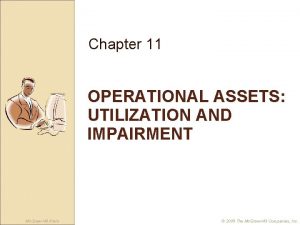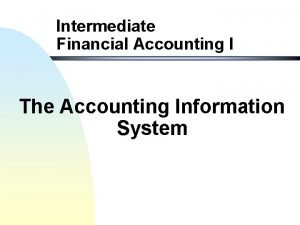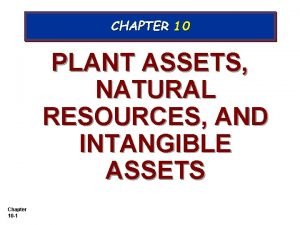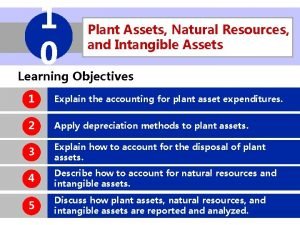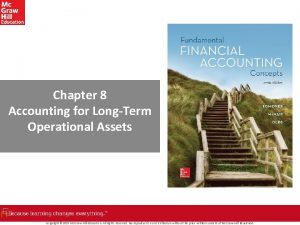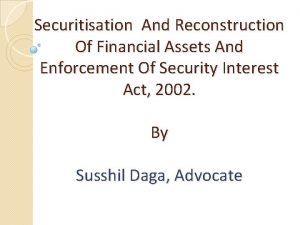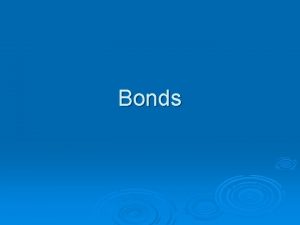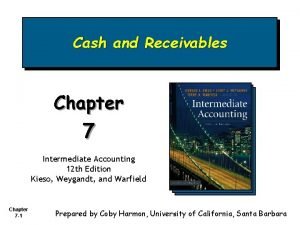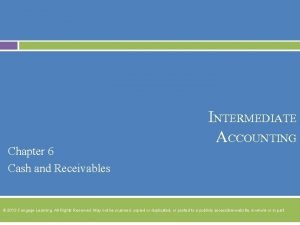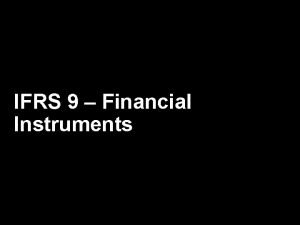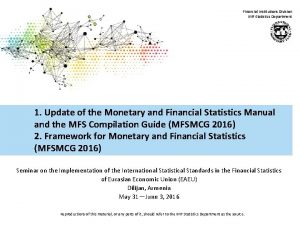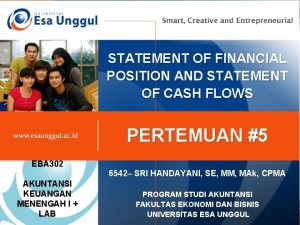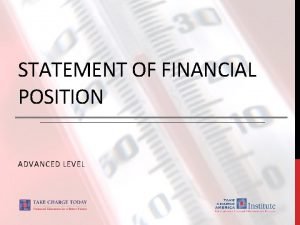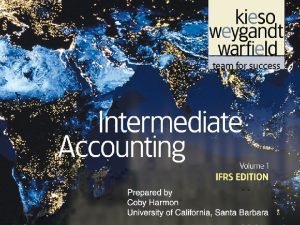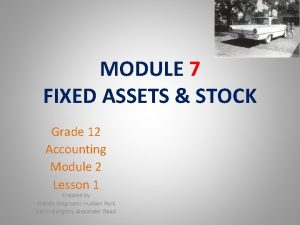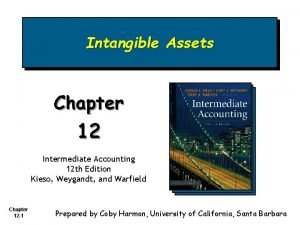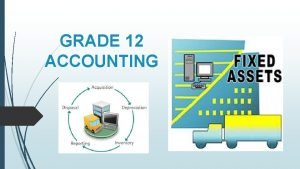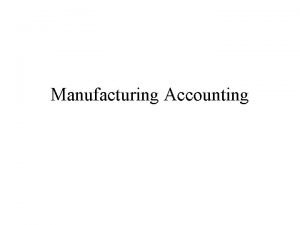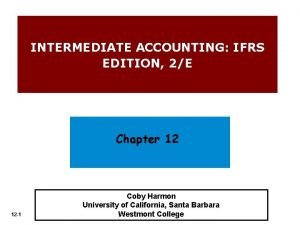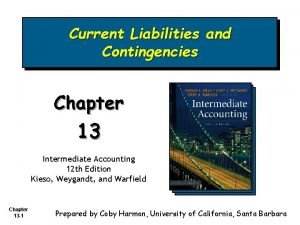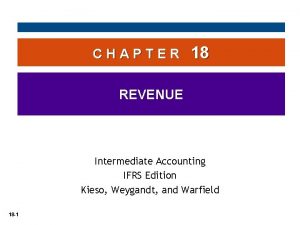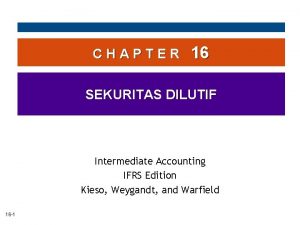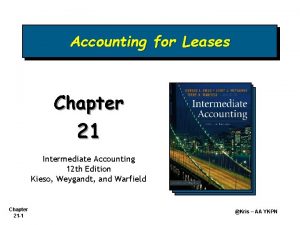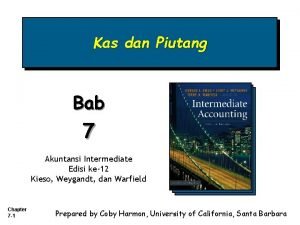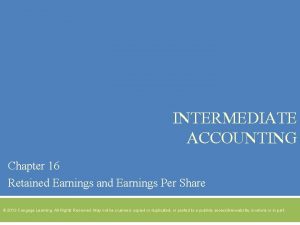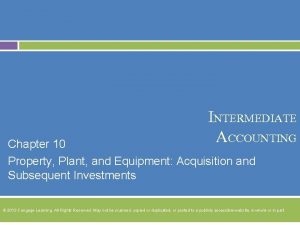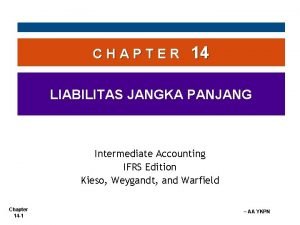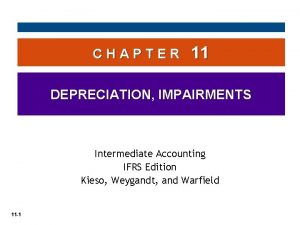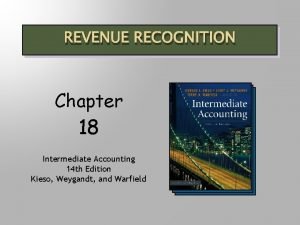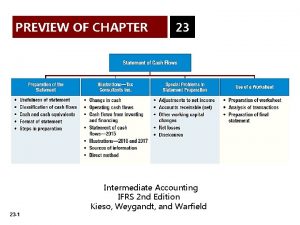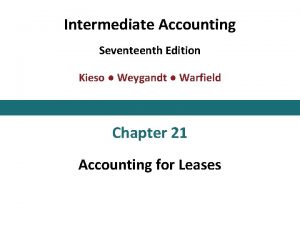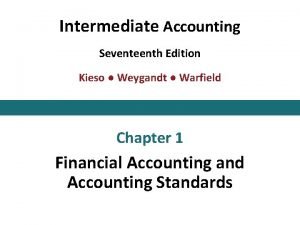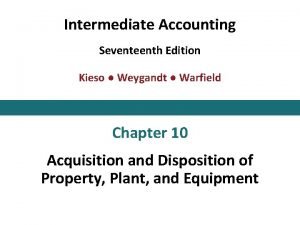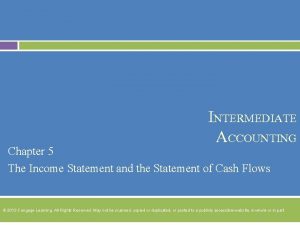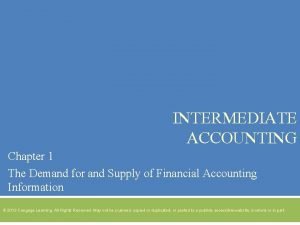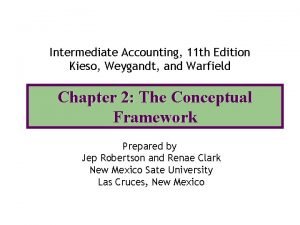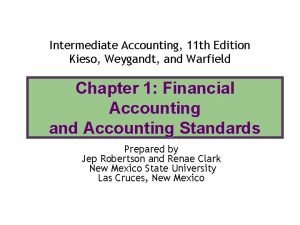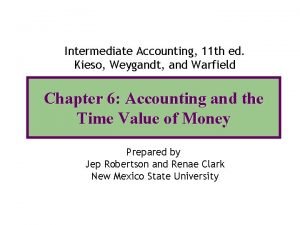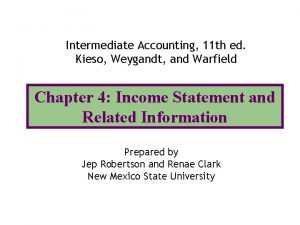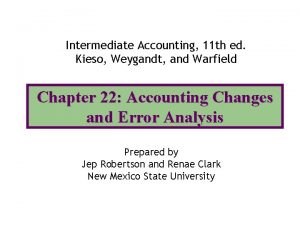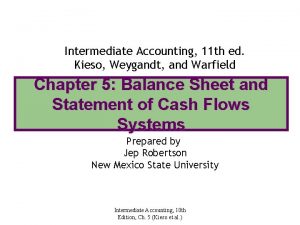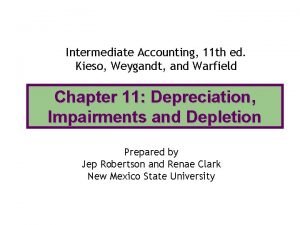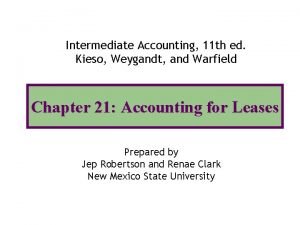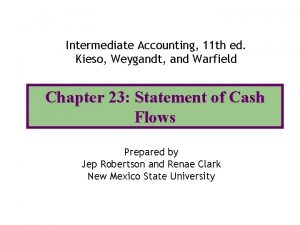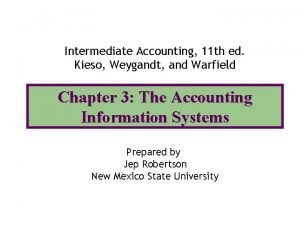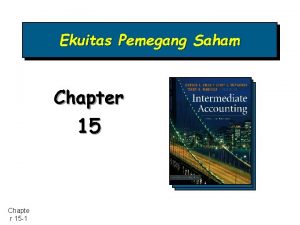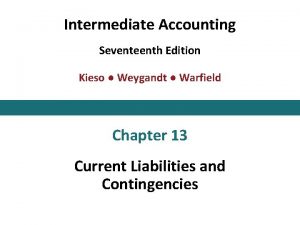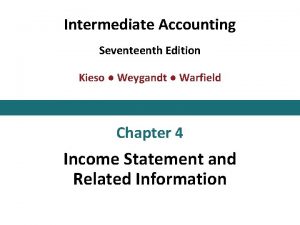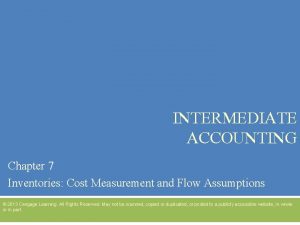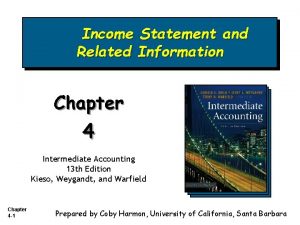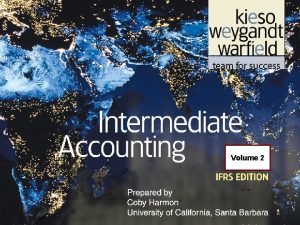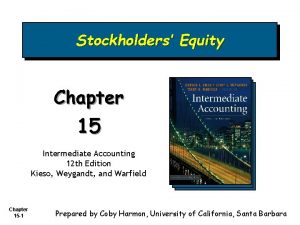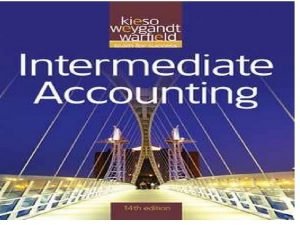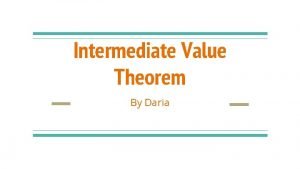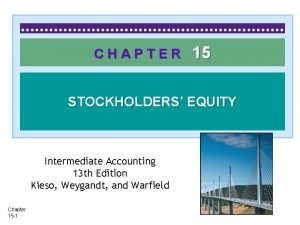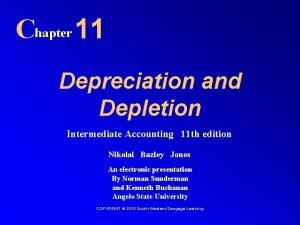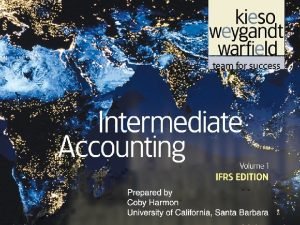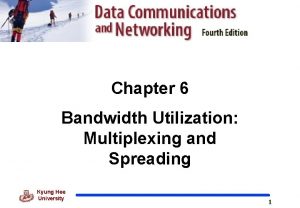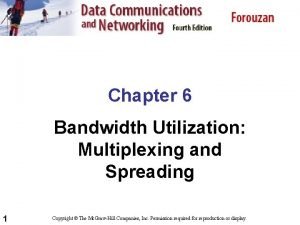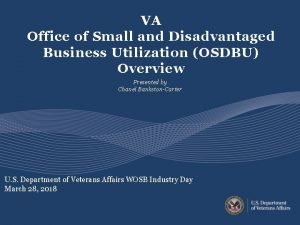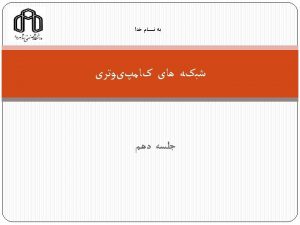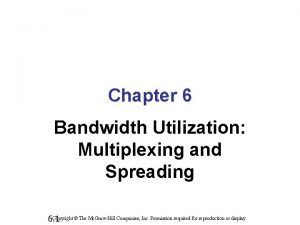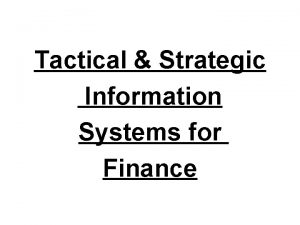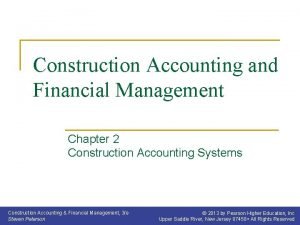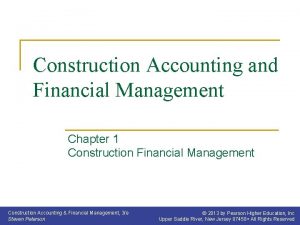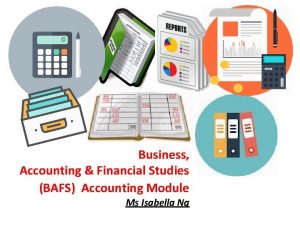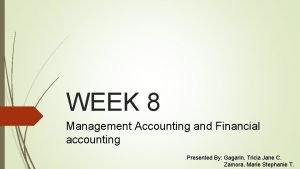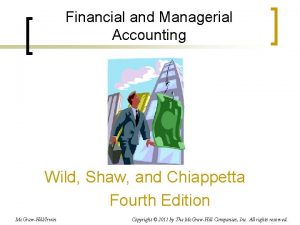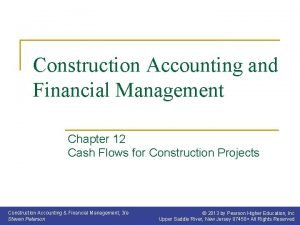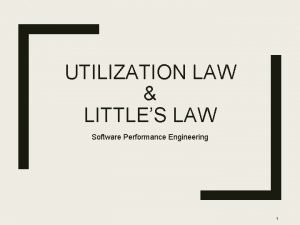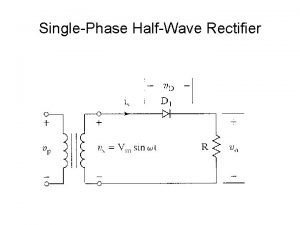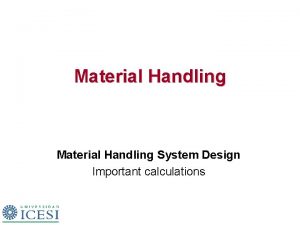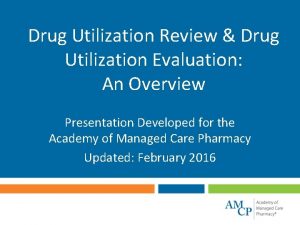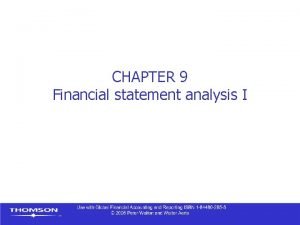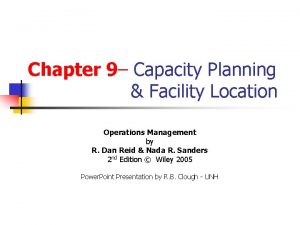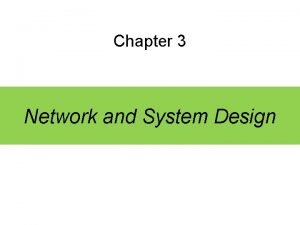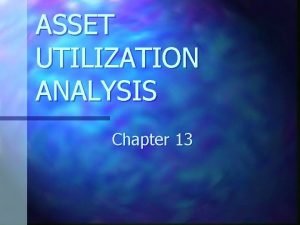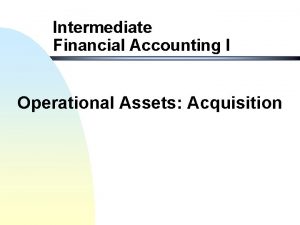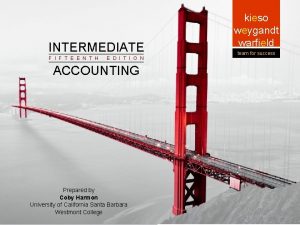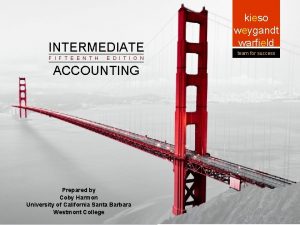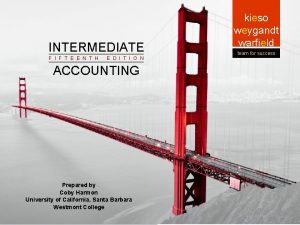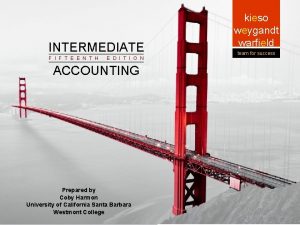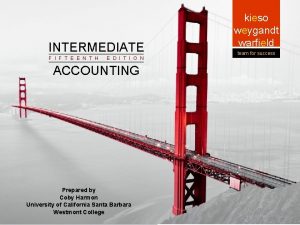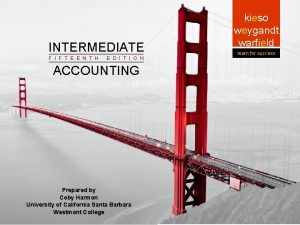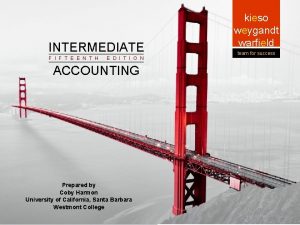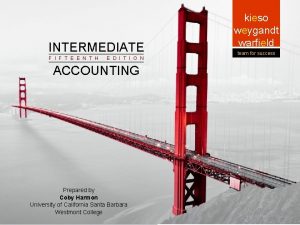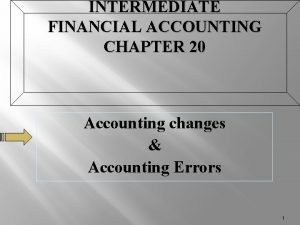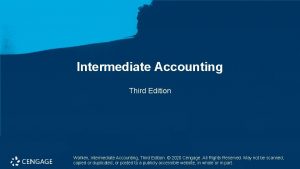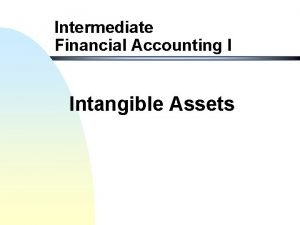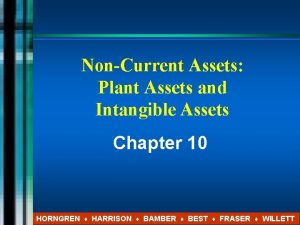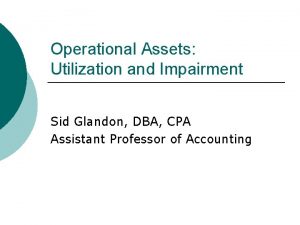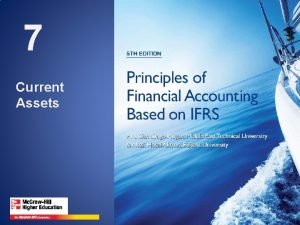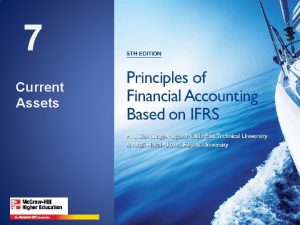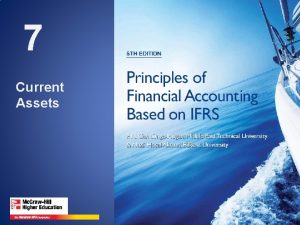Intermediate Financial Accounting I Operational Assets Utilization and


















































































































- Slides: 114

Intermediate Financial Accounting I Operational Assets: Utilization and Disposition

Objectives of the Chapter A. To learn depreciation methods for financial reporting purposes. B. To study income tax depreciation including Accelerated Cost Recovery System (ACRS) and modified ACRS. C. To discuss the accounting issues related to asset impairments. Operational Assets: Utilization and Disposition 2

A. Depreciation (For Financial Reporting Purposes) 1. Time-based methods a. Straight-Line. b. Sum-of-the-Years’-Digits (SYD). c. Declining-Balance. 2. Activity-based method u Unit-of-Production. 3. Special methods a. Group Depreciation. b. Composite Depreciation. c. Retirement and Replacement Methods. Operational Assets: Utilization and Disposition 3

i. GAAP: Depreciation § i. GAAP, as in US GAAP, perceives depreciation as a cost allocation of an asset over the asset’s life. § i. GAAP, as in US GAAP, allows depreciation methods such as straight line, diminishingbalance, and unit-of-production. § IFRS requires component depreciation. GAAP permits component deprecation but is rarely applied. Operational Assets: Utilization and Disposition 4

For Financial Reporting Purposes 1. Time-Based Methods n Depreciation Methods based on the passage of time: a. Straight-Line Method. b. Sum-of-the-Years’-Digits (SYD). c. Declining-Balance. b and c are called the accelerated depreciation methods (or the decreasing charge methods). Operational Assets: Utilization and Disposition 5

A. 1 a. Straight-Line Method n n Cost is allocated evenly through the life of the P. P. E. Example 1: Machine costing $10, 000 was purchased on 1/1/x 1. The estimated residual value of the machine is $2, 000 and the estimated life of the machine is 4 years. Depreciation Expense per year: ($10, 000 - 2, 000)/ 4 = $2, 000 12/31/x 1 Depreciation Expenses 2, 000 Accumulated Depreciation 2, 000 Operational Assets: Utilization and Disposition 6

1 a. Straight-Line Method (Partial Year Depreciation) n Example 2 : Using the information in example 1, except that the machine was purchased on 3/11/x 1. Companies normally compute depre. on the basis of nearest full month. Depreciation Expense of year x 1 ==> [($10, 000 -2, 000)/4] x (10/12) = $1, 667 Operational Assets: Utilization and Disposition 7

1 a. Straight-Line Method Example 2 (contd. ) (Book value = Cost - Acc. Depr) B/S (Year x 1) P. P. E. Machine Acc. Depr. Net B/V $10, 000 (1, 667) 8, 333 B/S (Year x 3) P. P. E Machine Acc. Depr. Net $10, 000 (5, 667) $ 4, 333 B/S (Year x 2) P. P. E Machine Acc. Depr. Net $10, 000 (3, 667) $6, 337 B/S (Year x 4) P. P. E Machine Acc. Depr. Net $10, 000 (7, 667) 2, 333 Operational Assets: Utilization and Disposition 8

1 b. Sum-of-the-Years’-Digits (SYD) n Example 1: Machine costing $10, 000 was purchased on 1/1/x 1 with an estimated residual value of $2, 000 and an estimated life of 4 years. Depr. **Book Value Year *Depr. Base Fraction Expense at the end x 1 $8, 000 4/10 $3, 200 6, 800 x 2 $8, 000 3/10 $2, 400 4, 400 x 3 $8, 000 2/10 $1, 600 2, 800 x 4 $8, 000 1/10 $800 2, 000 * Depr. Base= Cost - Residual Value ** Book Value= Cost - Acc. Depreciation Operational Assets: Utilization and Disposition 9

1 b. S-Y-D (contd. ) n Example 2: (Partial Year) Same information as in example 1 on page 8 except that the machine was purchased on 2/21/x 1 rather than on 1/1/x 1. The depr. period of Year x 1 = 10 months Operational Assets: Utilization and Disposition 10

Example 2 (contd. ) 1 b. S-Y-D Annual Depr. By S-Y-D Depr. Year Method Months Computation Exp 1 x 1 $3, 200 10 10/12 x 3200= $2, 667 2 x 2 $2, 400 12 3 x 3 $1, 600 12 4 x 4 $800 12 5 x 5 - 2 2/12 x 3200+ 10/12 x 2400= $2, 533 2/12 x 2400+ 10/12 x 1600= $1, 733 2/12 x 1600+ 10/12 x 800= $934 2/12 x 800= $133 Operational Assets: Utilization and Disposition 11

1 c. Declining-Balance Method n Depreciation Exp. = constant rate book value at the beginning of the period u. Residual value is not considered in the computation. u. Assets cannot be depreciated below the residual value. u. The constant rate is expressed as a function of a straight-line annual depreciation rate. Operational Assets: Utilization and Disposition 12

1 c. Declining-Balance Method (contd. ) n Example of constant rate: Life S-L of Depr. Asset Rate 4 yrs 25% Double. Declining. Balance Depr. Rate 50% 150% Declining. Balance Depr. Rate 37. 5% 5 yrs 20% 40% 30% 10 yrs 10% 20% 15% Operational Assets: Utilization and Disposition 13

1. Time-Based Methods Double Declining-Balance Method n Example 1: Machine costing $10, 000 purchased on 1/1/x 1, with a residual value of $2, 000 and an estimated life of 4 years. A double declining-balance method is used to depreciate the machine. Thus, the constant rate is twice of the S-L Depr. Rate (2 x 25% = 50%). Operational Assets: Utilization and Disposition 14

Double Declining-Balance Method Example 1 (contd. ) Book Value of Asset at Beg. of Constant Depr. Book Value Year the Year Rate Exp. At the End x 1 $10, 000 50% $5, 000 x 2 $5, 000 50% 2, 500 x 3 $2, 500 50% 500* 2, 000* x 4 2, 000 50% 0 2, 000 *Assets cannot be depreciated below the residual value. Operational Assets: Utilization and Disposition 15

Double Declining-Balance Method Example 2 (partial year) n Use the same information as the example on page 13, except that the machine was purchased on 3/10/x 1. The depreciation period of Year x 1 = 10 months. u Two alternative treatments for the partial year depreciation of the decliningbalance method are available as follows: u Operational Assets: Utilization and Disposition 16

Double Declining-Balance Method Example 2 (contd. ) Alternative I Annual Depr. Using the Recognized D-D-B Months Computations Depr. Exp. 1 x 1 $5, 000 10 10/12 x 5000= $4, 167 2 x 2 $2, 500 12 3 x 3 $500 12 4 x 4 5 x 5 0 0 12 2 2/12 x 5000+ 10/12 x 2500= 2/12 x 2500+ 10/12 x 500= 2/12 x 500= - Operational Assets: Utilization and Disposition $2, 916 $834 $83 17

Double Declining-Balance Method Example 2 (contd. ) Alternative II Book Value Year at Beg. Rate x 1 $10, 000 50% x 2 $5, 833 50% x 3 x 4 $2, 916 $2, 000 50% Depr. Exp. 10/12 x(10, 000 x 50%)= 4, 167 12/12 x(5, 833 x 50%)= 2, 917 916 0 Book Value At the End $5, 833 2, 916 2, 0001 2, 000 1. Assets cannot be depreciated below the residual value. Operational Assets: Utilization and Disposition 18

1. Time-Based Methods A Comparison of Depreciation Methods Assuming expected life = 4 years 1. Straight-Line Method 2. S-Y-D Method 3. Declining-Balance Method Depreciati on Expense 1 3 2 Yea r Operational Assets: Utilization and Disposition 19

Changes In Depreciation Method (i. e. , Change from DD-B to S-L) n Accounting treatment (SFAS No. 154: Accounting Changes and Error Corrections, effective 1/1/2006): n Treated as an accounting estimate change that is achieved by change in accounting principle. u Method: Prospective method. u The accounting for depreciation method change is an example of revising US GAAP to converge to i. GAAP. Operational Assets: Utilization and Disposition 20

1. Time-Based Methods Changes In Depreciation Estimate n Accounting treatment: no retroactive effect and make no adjustment for the past years’ misstatement. Spread the remaining undepreciated balance (i. e. , the book value) less the revised (new) residual value over the revised (new) estimate of the remaining life of the assets. Operational Assets: Utilization and Disposition 21

Example: (S-L Depr. Method) n Machine costing $10, 000 acquired on 1/1/x 1. Estimates on 1/1/x 1 on 1/1/x 3 Residual value $2, 000 $1, 000 Life 4 years 5 years Operational Assets: Utilization and Disposition 22

Example: (Contd. ) Year Depr. Exp Acc. Depr Book Value x 1 $2, 0001 2, 000 8, 000 x 2 $2, 0002 4, 000 6, 000 x 3 $1, 667 5, 666. 7 4, 333. 3 x 4 $1, 667 7, 333. 4 2, 666. 6 x 5 $1, 667 9, 000. 1 1, 000 1. (10, 000 -2, 000)/4 = $2, 000 2. (6, 000 -1, 000)/(5 -2) =1666. 7 Operational Assets: Utilization and Disposition 23

For Financial Reporting Purposes 2. Activity-Based Method n Depreciation based on the usage of assets. Depreciation bases -- hours of usage or production units. Method: u. Units-of-Production Method: depreciation based on the usage of the asset Operational Assets: Utilization and Disposition 24

2. Activity-Based Method Example n Machine costing $10, 000 was purchased on 5/20/20 x 1 with an estimated residual value of $2, 000 and an estimated service hours of 8, 000 hours. Depreciation expense per hour = ($10, 000 - 2, 000)/8, 000 hours = $1 per hour Operational Assets: Utilization and Disposition 25

2. Activity-Based Method Example (contd. ) n During 20 x 1, the machine was used for 1, 000 hours, the depreciation expense of 20 x 1: $1 x 1, 000 = $1, 000 J. E. 12/31/x 1 Depreciation Expense 1, 000 Accumulated Depreciation 1, 000 Operational Assets: Utilization and Disposition 26

For Financial Reporting Purposes 3. Special Methods a. Group Depreciation (Group-Rate Method). b. Composite Depreciation (Composite. Rate Method). c. Retirement and Replacement Methods (used by special Industries--public utilities and railroads). Operational Assets: Utilization and Disposition 27

3 a. &b. Group and Composite Methods n One depreciation rate is applied to multiple assets (i. e. , telephone poles, switch boards, etc). u Group Method: Used when assets have similar economic lives and other attributes. u Composite Method: Used when assets are physically dissimilar (i. e. , a group of heterogeneous assets). Operational Assets: Utilization and Disposition 28

Group and Composite Methods (contd. ) n n Both methods apply a single straight-line rate based on the average service lives of the group assets. Once the group depreciate rate is determined, it usually is used despite the addition or disposition of individual assets in the group. Operational Assets: Utilization and Disposition 29

Group and Composite Methods (contd. ) n When these methods are applied: 1. No partial year depreciation regardless of when these assets were purchased. 2. No gain or loss can be recognized in disposition of group assets except for the disposition of last piece(s) of assets in the group. 3. Cannot depreciate the remaining assets to below their residual value. Operational Assets: Utilization and Disposition 30

Examples (Group Method) n Five machines were purchased on 3/5/x 1 at $10, 000 each. All machines were expected to last 4 years with a residual value of $2, 000 each. Depreciation expense per year = ($50, 000 -10, 000)/4 = $10, 000 Group annual depreciation rate = $10, 000/$50, 000 = 20% (of cost) Operational Assets: Utilization and Disposition 31

3 a. Group Method Example I n Use the information on page 29 (assuming no early retirement or new purchase within 4 years), the following J. E. would be recorded at the end of year: 12/31/x 1 Depr. Exp 10, 000 Acc. Depr. 10, 000 12/31/x 2 Depr. Exp 10, 000 Acc. Depr. 10, 000 12/13/x 3 Depr. Exp 10, 000 Acc. Depr. 10, 000 12/31/x 4 Depr. Exp 10, 000 Acc. Depr. 10, 000 Operational Assets: Utilization and Disposition 32

3 a. Group Method Example I (contd. ) n Five machines were sold (disposed) on 3/5/x 5 for $1, 500 each. J. E. (The Retirement of 5 machines) 3/5/x 5 Cash 7, 500 Acc. Depr. 40, 000 Loss on Disposal 2, 500 Machine 50, 000 Operational Assets: Utilization and Disposition 33

3 a. Group Method Example II n Use information on page 29 and assume one machine was sold for $6, 000 on 3/10/x 3. Two were sold for $5, 000 each on 8/9/x 4 and the last two were discarded on 9/20/x 5. 12/31/x 1 (Recording the group depreciation expenses for Year x 1) Depreciation Expenses 10, 000 Accumulated Depreciation 10, 000 ($50, 000 x 20% = $10, 000) (Total Cost) x (Group Rate) Operational Assets: Utilization and Disposition 34

3 a. Group Method Example II (contd. ) 12/31/x 2 (Group Depreciation Expenses for Year x 2) Depreciation Expenses 10, 000 Accumulated Depreciation 10, 000 ($50, 000 x 20% = $10, 000) 3/10/x 3 (the disposal of the first machine) Cash 6, 000 Accumulated Depreciation 4, 000 a Machine 10, 000 a. No gain or loss can be recognized. Operational Assets: Utilization and Disposition 35

3 a. Group Method Example II (contd. ) 12/31/x 3 (Group Depreciation Expenses for Year x 3) Depreciation Expenses 8, 000 Accumulated Depreciation 8, 000 [($50, 000 - $10, 000) x 20% = $8, 000] Cost for the Group rate remaining 4 machines Machine 50, 000 10, 000 40, 000 Operational Assets: Utilization and Disposition 36

3 a. Group Method Example II (contd. ) 8/9/x 4 (Sold 2 machines for $5, 000 each) Cash 10, 000 Accumulated Depreciation 10, 000 a Machine 20, 000 a. No gain or loss can be recognized 12/31/x 4 (Depreciation Expenses for Year x 4) Depreciation Expenses 2, 000 b Accumulated Depreciation 2, 000 [($50, 000 - $10, 000 - 20, 000) x 20% = $4, 000] Cost for the remaining 2 machines rate Group b. See explanations. Operational on page Assets: 36. Utilization and Disposition 37

3 a. Group Method Example II (contd. ) Accumulated Depreciation (Before 12/31/x 4) Year x 3 … 4, 000 10, 000 … Year x 1* Year x 4… 10, 000 … Year x 2 8, 000 … Year x 3 14, 000 ** * Therefore, book value of the last two machines before depreciation of Year x 4 => $20, 000 -14, 000 = $6, 000 ** As a result, maximum depreciation expense allowed for the last 2 machines => (why? ? ) $6, 000 - (2, 000 x 2) = $2, 000 Operational Assets: Utilization and Disposition 38

3 a. Group Method Example II (contd. ) 9/20/x 5 (Discard the Last Two Machines) Accumulated Depreciation (Before 12/31/x 5) x 3. . . 4, 000 10, 000 … x 1 x 4. . . 10, 000 … x 2 8, 000 … x 3 2, 000 … x 4 16, 000 Accumulated Depreciation Loss on Disposal Machine 16, 000 4, 000 Operational Assets: Utilization and Disposition 20, 000 39

3 a. Group Method Comments n n No gain or loss can be recognized for the disposal of group assets except for the last unit(s). (Example, see example II, Journal Entry for 3/10/x 3 and 8/9/x 4) Cannot depreciate group assets to below their residual value. (Example, see journal entry of example II on 12/31/x 4) Operational Assets: Utilization and Disposition 40

3 a. Group Method Comments (contd. ) n If a similar asset were purchased and added to the group, a new group depreciation rate may be computed as follows: (Book value of the old in the group + cost of the new asset - estimated residual value of the group) / (weighted average lives of the assets in the group) (see example III) Operational Assets: Utilization and Disposition 41

3 a. Group Method Example III (calculating new group depr. rate) n Use the example on page 29. Additional information is as follows: One machine was sold on 4/10/x 3 for $7, 000. A similar new machine was acquired on 8/19/x 4 for $12, 000 with an expected life of 4 years and $2, 000 residual value. Two machines were sold on 9/10/x 4 for $5, 000 each. The last three machines were sold on 10/5/x 5 for $1, 000, $2, 000 and $1, 500, respectively. Operational Assets: Utilization and Disposition 42

3 a. Group Method Example III (contd. ) Journal Entries: 3/5/x 1 (Purchasing of 5 machines on 3/5/x 1) Machine 50, 000 Cash 50, 000 12/31/x 1 (Recording Depr. Exp. for Year x 1) Depreciation Expense 10, 000 Accumulated Depreciation 10, 000 12/31/x 2 (Depreciation Expenses of Year x 2) Depreciation Expense 10, 000 Accumulated Depreciation 10, 000 Operational Assets: Utilization and Disposition 43

3 a. Group Method Example III (contd. ) 4/10/x 3 Cash Accumulated Depreciation Machine 7, 000 3, 000 10, 000 12/31/x 3 Depreciation Expense 8, 000 Accumulated Depreciation 8, 000 8/19/x 4 Machine Cash 12, 000 Operational Assets: Utilization and Disposition 12, 000 44

3 a. Group Method Example III (contd. )-New Group Depreciation Rate Depreciation Expense = [($15, 000+$12, 000)1 - ($2, 000 x 4+2, 000)2]/1. 6 years 3 = $10, 625 New Group Depreciation Rate = $10, 625 / ($40, 000 + 12, 000)4 = 20. 43% 1. Book Value of the remaining 4 machines. 2. Residual value of 4 remaining machines and the new one. 3. The W-A lives of remaining machines and the new one =>[(4 -3) x 4 + 4] / 5 = 1. 6 (years) 4. Total cost of 4 remaining machines and the new one. Operational Assets: Utilization and Disposition 45

3 a. Group Method Example III (contd. ) Journal Entries: 9/10/x 4 Cash Accumulated Depreciation Machine 12/31/x 4 Depreciation Expense 1 Accumulated Depreciation 10, 000 20, 000 6, 538 1. (62, 000 -30, 000) x 20. 43% = $6, 538 Operational Assets: Utilization and Disposition 46

3 a. Group Method Example III (contd. ) 10/5/x 5 sold the last 3 machines (update the depreciation expenses for Year x 5 because the group is not fully depreciated to the residual value of $6, 000) Depreciation Expenses Accumulated Depreciation 4, 4621 Cash Accumulated Depreciation Loss on Disposal Machine 4, 500 26, 000 1, 500 4, 462 32, 000 1. See explanation on next page. Operational Assets: Utilization and Disposition 47

3 a. Group Method Example III (contd. ) Machine 3/x 1 50, 000 10, 000 … 4/x 3 8/x 4 12, 000 20, 000 … 9/x 3 32, 000 Accumulated Depreciation 4/x 3… 3, 000 10, 000 … 12/x 1 9/x 4… 10, 000 … 12/x 2 8, 000 … 12/x 3 6, 538 … 12/x 4 21, 538 Operational Assets: Utilization and Disposition 48

3 a. Group Method Example III (contd. ) * Book value of the last 3 machines on 10/5/x 5 before the adjusting entry = $32, 000 - 21, 538 = 10, 462 Residual Value of the last 3 machines = $2, 000 x 3 = $6, 000 ==> max. depreciation expenses for Year x 5 = 10, 462 - 6, 000 = $4, 462 20. 43% x $32, 000 = $6, 538 > $4, 462 ==> Depreciation exp. for Year x 5 = $4, 462 Operational Assets: Utilization and Disposition 49

Special Methods b. Composite Method (Apply to a group of dissimilar assets with different expected lives and different salvage value) u. Example: (All assets were purchased on 2/1/x 1) Operational Assets: Utilization and Disposition 50

3 b. Composite Method Example (contd. ) Composite Rate = $56, 000/ $224, 000 = 25% Composite Life = $190, 000/56, 000 = 3. 39 (years) 12/31/x 1 Depreciation Expense 56, 000 Accumulated Depreciation 56, 000 Operational Assets: Utilization and Disposition 51

3 b. Composite Method Comments n n n Apply to a group of dissimilar assets. No partial year depreciation. All rules that are applied to the group depreciation method also are applied to the composite depreciation method. No gain or loss can be recognized when composite assets are retired except for the last piece (pieces) of assets being disposed. Operational Assets: Utilization and Disposition 52

3 b. Composite Method Comments (contd. ) n n Cannot depreciate assets remained in the group to below the residual value If a new asset is purchased, a new composite rate may be calculated. Operational Assets: Utilization and Disposition 53

3 b. Composite Method Retirement of Composite Assets (Similar accounting treatment as for the retirement of group assets -- no gain or loss can be recognized except for the disposal of the last asset(s) in the group). u i. e. , Trunk 101 was sold on 3/8/x 2 for $1, 000. The cost for truck 101 is $8, 000. Operational Assets: Utilization and Disposition 54

Retirement of Composite Assets (contd. ) 3/8/x 2 Cash Accumulated Depr. Truck 1, 000 7, 000 8, 000 At the end of the year, the composite rate 25% would be applied to: ($224, 000 - 8, 000) = $216, 000 x 25% = $54, 000 12/31/x 2 Depreciation Exp. 54, 000 Accumulated Depr. 54, 000 Operational Assets: Utilization and Disposition 55

Special Methods c. Retirement and Replacement Methods n Used by public utilities and railroad companies which own many similar units of small value (i. e. poles, conductors, telephones, …). u Retirement Method: Charge the cost of the retired assets (less salvage) to depreciation expense. u Replacement Method: Charge the cost of newly purchased assets (less the salvage value of the replaced assets) to depreciation expense. Operational Assets: Utilization and Disposition 56

3 c. Retirement and Replacement Methods Example In 20 x 2, Greenway Co. purchased small tools costing $10, 000. In 20 x 3, tools originally costing $3, 000 were sold for $100 and replaced with new tools costing $4, 000. Determine the depreciation expense for the small tools for the year of 20 x 3. Under the retirement method: $2, 900 Uner the replacement method: $3, 900 Operational Assets: Utilization and Disposition 57

3 c. Retirement and Replacement Methods Example (cont. ) Journal entries (under the retirement method) 20 x 2 Small Tools 10, 000 Cash 10, 000 to record the acquisition of small tools 20 x 3 Small Tools 4, 000 Cash 4, 000 to record the additional small tool acquisition Operational Assets: Utilization and Disposition 58

3 c. Retirement and Replacement Methods Example (cont. ) Journal entries (retirement method cont. ) 20 x 3 Cash 100 Depreciation expense 2, 900 Small tools 3, 000 to record sale/depre. of small tools Operational Assets: Utilization and Disposition 59

3 c. Retirement and Replacement Methods Example (cont. ) Journal entries (under the replacement method) 20 x 2 Small Tools 10, 000 Cash 10, 000 to record the acquisition of small tools 20 x 3 Small Tools 4, 000 Cash 4, 000 to record the additional small tool acquisition Operational Assets: Utilization and Disposition 60

3 c. Retirement and Replacement Methods Example (cont. ) Journal entries (replacement method cont. ) 20 x 3 Cash 100 Depreciation expense 3, 900 Small tools 4, 000 to record sale/depre. of small tools Operational Assets: Utilization and Disposition 61

3 c. Retirement and Replacement Methods Comments 1. No depreciation expense recognized until assets are retired or replaced. 2. For railroad companies, these methods are rarely used after 1983 due to ICC required railroads to switch to traditional depreciation accounting (i. e. , S-L method, SYD…). Operational Assets: Utilization and Disposition 62

Disclosure of Depreciation (APB No. 12) 1. Depreciation expense for the period. 2. Balances of major classes of depreciable assets at the balance sheet date. 3. Accumulated depreciation, either by major classes of depreciable assets or in total, at the balance sheet date. 4. A general description of the method or methods used with respect to major classes of depreciable assets. Operational Assets: Utilization and Disposition 63

The Use of Alternative Depreciation Methods -- Statistics from a Survey of 600 Companies Source: Accounting Trends and Techniques 1 Method 2010 2007 2001 1998 1991 1990 Straight Line 488 592 576 578 558 560 Declining balance 10 16 22 26 28 38 Sum of the years’ digits 3 5 7 10 8 11 An Accelerated method (not specified) Units of production Group/composite 17 27 53 50 70 69 16 1 23 9 34 39 50 50 1. There are more than 600 responses because many companies use more than one method of depreciation. Operational Assets: Utilization and Disposition 64

Miscellaneous Points Related To Depreciation n Group method is applied to a group of homogeneous assets with similar lives and attributes (may or may not have the same residual value). Composite method is used when assets are physically dissimilar but are aggregated for convenience. Hybrid of combination methods: GAAP allows any systematic and rational way to allocate costs. Steel industry uses a combination of straight-line and activity based method (a production variable method). Operational Assets: Utilization and Disposition 65

Miscellaneous Points Related To Depreciation (contd. ) Selection of a depreciation method is based n n n on the goal of the company. There is no cash flow involved in the deprecation. The depreciation method change should not have an impact on stock price based on the efficient market hypothesis. This is supported by some research (Kaplan & Roll, 1972). Partial year depreciation is computed on the basis of the nearest Operationalfull Assets: month. Utilization and Disposition 66

For Income Tax Reporting Purposes B. Income Tax Depreciation n Tax Depreciation in different periods: 1. GAAP depreciation methods (i. e. , S-L, SYD or DDB): Apply to assets acquired before 1981; cannot be depreciated to below the residual value. IRS published tables with estimated lives for depreciable assets. 2. ACRS: Accelerated Cost Recovery System applies to assets purchased between 1981 - 1986. 3. Modified ACRS: MACRS applies to assets purchased in 1987 or later. Operational Assets: Utilization and Disposition 67

Tax Depreciation ACRS & MACRS vs. GAAP n ACRS and MACRS differ with GAAP depreciation in the following aspects: a. a mandated tax life, which is generally shorter than the economic life; b. cost recovery on an accelerated basis; c. an assigned salvage value of zero (i. e. , salvage = $0); d. Assume assets acquired in the mid-year. Operational Assets: Utilization and Disposition 68

Tax Depreciation 2. ACRS (Skip) n n n Classify depreciable assets into five classes (i. e. , 3, 5 , 10, 15 and 18 year classes). Have a tax rate table for each class. Examples of classes: 3 -year class: cars, light-duty trucks, equipment. . 5 -year class: office furniture, heavy duty truck. . 10 -year class: depreciable real estate. . 15 -year class: 18 -year class: buildings. Operational Assets: Utilization and Disposition 69

2. ACRS (contd. ) (Skip) Rate Table for ACRS: 3 -year 25% 38% 37% 5 -year 15% 22% 21% 21% 10 -year 18% 14% 12% 10% 9% 9% 9% 15 -year 5% 10% 9% 8% Operational Assets: Utilization and Disposition 70

Tax Depreciation 3. MACRS n MACRS was enacted by Congress in the Tax Reform Act of 1986. Assets are classified in 8 property classes instead of 5 classes as in ACRS. In addition, a specified GAAP depreciation method is used in computing the depreciation expense for all classes. Operational Assets: Utilization and Disposition 71

MACRS Depreciation Methods MACRS Depreciation Method Property Class u. Double-Declining Balance 3, 5, 7 or 10 -year property u 150% Declining Balance u. Straight-Line 15 or 20 -year property 27. 5 or 39 year property Operational Assets: Utilization and Disposition 72

MACRS Property Classes 3 -year property: small tools, horses, assets used in R&D activities. 5 -year property: automobiles, trucks, computers, peripheral equipment, office machines. 7 -year property: office furniture, equipment. 10 -year property: railroad tank cars, mobile homes. Operational Assets: Utilization and Disposition 73

MACRS Property Classes (contd. ) 15 -year property: roads, shrubbery, low- income housing, sewage treatment plants. 20 -year property: certain real estate. 27. 5 -year property: residential rental property. 39 -year property: nonresidential real property. Operational Assets: Utilization and Disposition 74

Principles Applied to MACRS 1. No residual value assigned (100% depreciation for tax purposes). All proceeds from the disposal of a fully depreciated asset are fully taxable. 2. Assume acquired in the mid-year (half-year convention). 3. When applying 150% declining balance(DB) method or DDB method, the depreciation method should be switched to S-L method if S-L method results in a higher depreciation expense than that of the DB method. Operational Assets: Utilization and Disposition 75

MACRS Example Cost= $200, 000 (purchased on 10/2/x 1). F Expected life= 8 years. F Salvage= $40, 000. F GAAP depr. method= Straight-Line. F MACRS life = 5 years. F MACRS method= Double-Declining Balance Method. F Disposal proceeds – 1/2/x 9 = $22, 000 F Operational Assets: Utilization and Disposition 76

MACRS Example (contd. ) Year Depr. Exp x 1 $200, 000 40% 0. 5= 40, 000 x 2 160, 000 40% = 64, 000 x 3 96, 000 40% = 38, 400 x 4 57, 600 40% = 23, 040 x 5 34, 560/ 1. 51 = 23, 040 x 6 11, 520 Dep. % Book. V 20% 160, 000 32% 96, 000 19. 2% 57, 600 11. 52% 34, 560 11. 52% 11, 520 5. 76% 0 1. DDB depr for year x 5 is 34, 560 40% = 13, 824. The S-L method results in a higher depr. exp. (i. e. , $23, 040) than that of DDB in year x 5. Thus, the depr. Method should be switched to the S-L method in x 5. Operational Assets: Utilization and Disposition 77

GAAP Depreciation and Gain/Loss at Disposal § Annual GAAP depreciation = ($200, 000 -40, 000)/8 =$20, 000 § Accumulated GAAP depre. over 8 years = $20, 000 x 8= $160, 000 § Disposal loss for finanical reporting = $22, 000 - 40, 000 = -18, 000 § Disposal gain for tax filing= $22, 000 – 0 =22, 000 Operational Assets: Utilization and Disposition 78

Gain/Loss at Disposal (contd. ) § Total expense recognized for tax filing = accumulated tax depreciation – disposal gain = $200, 000 -22, 000= $178, 000 § Total GAAP expense = accumulated GAAP depreciation + disposal loss = $160, 000+18, 000=178, 000 § Even though the net effects on income (i. e. , $178, 000 total expense) are the same, MACRS enables companies to defer income tax payments to later years. Operational Assets: Utilization and Disposition 79

Table 11 A-3 MACRS DEPR. RATES BY CLASS OF PROPERTY Recovery 3 -year 5 -year 7 -year 10 -year 15 -year 20 -year Year (200% DB) (150% DB) . 1 33. 33 20. 00 14. 29 10. 00 5. 00 3. 750 2 44. 45 32. 00 24. 49 18. 00 9. 50 7. 219 3 14. 81* 19. 20 17. 49 14. 40 8. 55 6. 677 4 7. 41 11. 52* 12. 49 11. 52 7. 70 6. 177 5 11. 52 8. 93* 9. 22 6. 93 5. 713 6 ………. . 5. 76 8. 92 7. 37 6. 23 5. 285 7 8. 93 6. 55* 5. 90* 4. 888 8 4. 46 6. 55 5. 90 4. 522 9 6. 56 5. 91 4. 462*80 Operational Assets: Utilization and Disposition

Table 11 A-3 (contd. ) Recovery 3 -year 5 -year 7 -year 10 -year 15 -year 20 -year Year (200% DB) (150% DB) 10 6. 55 5. 90 11 ……………… 3. 28 5. 91 12 5. 90 13 5. 91 14 5. 90 15 5. 91 16 2. 95 17 18 19 20 21 Operational Assets: Utilization and Disposition 4. 461 4. 462 4. 461 2. 23181

Tax Versus GAAP Depreciation § Purpose of tax depreciation: to raise revenue. § Purpose of GAAP depreciation: for financial reporting to fairly reflect the performance of a company. § With difference purposes, tax depreciation is different from GAAP depreciation. Operational Assets: Utilization and Disposition 82

C. Asset n n a Impairments Unlike inventory which is reported at LCM, PPE and Intangibles are reported at cost except for impairments. An impairment occurs when the book value of an asset is not fully recoverable. a. Based on SFAS No. 144: Accounting for the Impairment or Disposal of Long-Lived Assets and SFAS No. 142: Goodwill and Other Intangible Assets Operational Assets: Utilization and Disposition 83

C. Asset Impairments (all intangibles related impairments (i. e. , C 1 b and C 1 c) should be deferred until chapter 12 is discussed) n C. 1: Operational Assets Held for Use a. b. c. n n Tangible assets and intangible assets with finite life (i. e. , patens, copyrights). Intangible assets with indefinite life other than goodwill (i. e. , trade names). Goodwill C. 2: Operational Assets Held for Sale C. 3: Operational Assets Held to be Disposed of other than by Sale Operational Assets: Utilization and Disposition 84

C. 1 a Operational Assets Held for Use – Tangible Assets and Finite-Life Intangibles (Patents, etc) n n SFAS No. 144 (effective 2002) requires test for impairment only when events or changes in circumstances indicate that the book value of this asset (or asset group) may not be recoverable. For the purpose of this test, assets are grouped at the lowest level in which the cash flows of each group are independent. Operational Assets: Utilization and Disposition 85

Events or Changes in Circumstances Which May Lead to an Impairment The following are examples of such events or changes in circumstances: 1. A significant decrease in the market price of the asset (asset group). 2. A significant adverse change in how the asset is being used or in its physical condition. 3. A significant adverse change in legal factors or in the business climate that affects the value of the asset. Operational Assets: Utilization and Disposition 86

Events or Changes in Circumstances Which May Lead to 4. an Impairment (Cont. ) An accumulation of costs significantly in excess of the amount originally expected for the acquisition or construction of an asset. 5. A current-period loss combined with a history of losses or a projection of continuing losses associated with an asset. 6. A realization that the asset will be disposed of significantly before the end of its estimated life. (not in SFAS 121) Operational Assets: Utilization and Disposition 87

The Accounting Treatment for Impairment (for Held for Use Tangible and finite-Life Intangibles) Steps: 1. Conduct the Recoverability Test. 2. Compute the Impaired Amount. Operational Assets: Utilization and Disposition 88

Step 1: Conduct the Recoverability Test n Compare the book value (BV) of the asset with the undiscounted expected future cash flows (EFCF) of the asset (asset group). If BV > Undiscounted EFCF, the impairment has occurred and the impaired amount should be written off. Operational Assets: Utilization and Disposition 89

Step 2: Compute The Impaired Amount n n Impaired amount = Book value - fair value (if the fair value is available) or Impaired amount = Book value – estimated fair value 1 (if fair value is not available) 1. discounted present value of the future cash flows of the asset can be the estimated fair value Operational Assets: Utilization and Disposition 90

Write Off the Impaired Amount n Recognition of Impairment Loss: Loss on Impairment 1 $$$$$ Accumulated Depre. $$$$$ 1. Reported as part of income from continuing operations, not extraordinary losses. Operational Assets: Utilization and Disposition 91

Impairment (contd. ) n n After the write off, the fair value (or the estimated fair value if fair value is not available) becomes the new cost base for depreciation. No restoration of impaired loss is allowed for tangibles and finite-life intangibles assets held for use. Operational Assets: Utilization and Disposition 92

i. GAAP –Assets Impairments n n n i. GAAP, as in US GAAP, allows reporting impairments on PPE. i. GAAP, as in GAAP, use fair value test to measure the impairments. In determining the impairment loss, i. GAAP compares the book value with the fair value (thus, i. GAAP is more strict than US GAAP in this test). Operational Assets: Utilization and Disposition 93

i. GAAP – PPE Valuation and Impairment (contd. ) n i. GAAP, unlike GAAP, permits write-ups for subsequent recoveries of impairment losses back to the amount before the impairments (i. e. , the reversals of impairment losses). Operational Assets: Utilization and Disposition 94

Impairment (contd. ) n Disclosure Requirements of impairment loss: 1. A description of the impaired asset or asset group. 2. The facts and circumstances leading to the impairment. 3. The amount of the loss. 4. The method used to determined the fair value. Operational Assets: Utilization and Disposition 95

C. 1. b. Intangibles with indefinite life Other than Goodwill – (Held-for. Use) n For indefinite life intangibles (i. e. , trade names) held for use, impairment test should be conducted at least annually or more often if events or changes in circumstances indicate an impairment. n Test of Impairment: one-step test => n Compare book value with the fair value. Operational Assets: Utilization and Disposition 96

C. 1. b. (contd. ) n n If book value > fair value, impairment loss exits and should be recognized. The fair value becomes the new cost base. A recovery of the impairment loss is prohibited. Disclosure requirements are similar to those of tangible and finite-life intangibles. Operational Assets: Utilization and Disposition 97

C. 1. c. Impairment for Goodwill (SFAS 142) n n The cost of goodwill cannot be directly associated with any specific identifiable right. Also, goodwill cannot be separated from the company (or a reporting unit)a as a whole. a. An operating segment of a company or a component of an operating segment for which discrete financial information is available and segment management regularly review the operating results of that component. Operational Assets: Utilization and Disposition 98

C. 1. c. Impairment for Goodwill (cont. ) n n Step 1: The impairment test for goodwill is to compare the book value of a reporting unit for goodwill unit with the fair value of this reporting unit. Reasons: 1)the value of goodwill is not associated with any specific cash flows of any specific asset; 2) goodwill is not separable from a particular reporting unit Operational Assets: Utilization and Disposition 99

Impairment for Goodwill (cont. ) n n If book value exceeds the fair value for the reporting unit of the goodwill, an impairment loss exists. The impairment test should be conducted at least annually or more often if impairment indicated. Operational Assets: Utilization and Disposition 100

Impairment for Goodwill (cont. ) n If goodwill is tested for impairment at the same time as other assets of the reported unit, the other assets must be tested first and adjusted for impairment (if any) prior to testing goodwill. Operational Assets: Utilization and Disposition 101

Impairment for Goodwill (cont. ) n n Step 2: If goodwill impairment exits, the goodwill impairment loss equals: Book value of goodwill – implied fair value of goodwilla a The implied fair value of goodwill is calculated in the same way that goodwill is determined in a business combination. Operational Assets: Utilization and Disposition 102

Impairment for Goodwill (cont. ) Example of calculating implied goodwill of a reporting unit: Determination of Implied goodwill: n Fair value of the reporting unit's net assets (excluding goodwill) Implied value of goodwill $400 million $330 million $ 70 million Operational Assets: Utilization and Disposition 103

Impairment for Goodwill (cont. ) Determination of impairment loss: Book value of goodwill Implied fair value of goodwill Impairment loss $320 million 70 million 250 million Operational Assets: Utilization and Disposition 104

C. 2 Impairment for Operational Assets to be Sold (SFAS 144) n If the impaired asset is to be disposed n ofa by sale, the following principles apply: 1. An impairment test needs to be conducted when an asset is considered as held for sale. 2. A one-step test: impairment exists when book value exceeds fair vale. a. Assets which managers have actively committed to sell immediately in their present condition and for which sale is probable, including assets held for sale of discontinued operations. Operational Assets: Utilization and Disposition 105

Impairment for Operational Assets to be Sold (cont. ) 3. The impaired amount = book value (fair value - disposal cost)a, b. 4. No depreciation after the write-down. a. Fair value – disposal cost = the net realizable value b. if the asset is unsold in the subsequent period, the restoration of the impairment loss is allowed when the fair value rebounded in the subsequent period. Operational Assets: Utilization and Disposition 106

C. 3 Impairment for Operational Assets to Be Disposed Other Than by Sale n n Examples of this type of assets: assets to be abandoned, exchanged for a similar assets or distributed to owners in a spinoff. SFAS 144 requires these assets to be treated as assets held for use until they are disposed of. Operational Assets: Utilization and Disposition 107

Summary of Asset Impairment: Assets Held for Use Asset Type When to Test Impair. Test To be used: Tangible and Intangible Events indicate BV not recoverable Two-Step: 1. BV > EFCF 2. BV - FV (finite life)) Intangible(inde Annually or finite, excluding more often goodwill) Goodwill Annually or more often One-Step: BV – FV 1. BV (reporting unit) > FV 2. BV of goodwill – implied FV Operational Assets: Utilization and Disposition 108

Summary of Asset Impairment: Assets Held to Be Disposed of Asset Type When to Test Impair. Test To be sold When One-Step: (including assets considered held BV > (FV-disposal cost) of discontinued for sale operations) No depreciation after write-down To be Considered as Depre. Life needs disposed of held for use until to be revised other than sale disposal based on APB 20 Operational Assets: Utilization and Disposition 109

The Impact of SFAS 144 on the Disposal Loss of Discontinued operations n n SFAS 144 applied to assets for both continuing and discontinued operations (Par. 41). Therefore, the assets held for sale of the discontinued operations are also reported at the lower of book value or the (fair value - cost to sell), not at the net realizable value as prescribed in APB 30. Operational Assets: Utilization and Disposition 110

The Impact of SFAS 144 on the Disposal Loss of Discontinued operations (contd. ) n Also, the future operating losses of the discontinued operations are no longer recognized before they occur under SFAS 144. Operational Assets: Utilization and Disposition 111

The Impact of SFAS 144 on the Disposal Loss of Discontinued operations (cont. ) n n The impairment loss (disposal loss) of the assets held for sale under the discontinued operations is reported as a component of the discontinued operations. See Chapter 4 notes for detailed discussion of the reporting of the operating results and disposal results for discontinued operations. Operational Assets: Utilization and Disposition 112

Impairment Losses and Earnings quality n n Similar to the write-down of inventory and restructuring costs, impairment losses can have significant adverse impact on the current year's income number. When fair value needs to be estimated, the estimation of fair value requires the forecast of future cash flows generated by the asset. Operational Assets: Utilization and Disposition 113

Impairment Losses and Earnings quality (contd. ) n n Companies can understate future cash flows to understate the fair value and overstate the write-down amount. By writing down large amounts of operational assets, companies are able to increase future earnings by lowering future depreciation, depletion or amortization. Operational Assets: Utilization and Disposition 114
 Real assets and financial assets ppt
Real assets and financial assets ppt Real and financial assets
Real and financial assets Real assets vs financial assets
Real assets vs financial assets Real assets versus financial assets
Real assets versus financial assets Assets utilization
Assets utilization Closing entries example
Closing entries example Intermediate financial accounting
Intermediate financial accounting Plant assets natural resources and intangible assets
Plant assets natural resources and intangible assets Plant assets natural resources and intangible assets
Plant assets natural resources and intangible assets Plant assets, natural resources, and intangible assets
Plant assets, natural resources, and intangible assets Long term operational assets
Long term operational assets Financial accounting and accounting standards chapter 1
Financial accounting and accounting standards chapter 1 Responsibility accounting
Responsibility accounting Securitisation and reconstruction of financial assets
Securitisation and reconstruction of financial assets Bonds and other financial assets
Bonds and other financial assets Notes receivable journal entry
Notes receivable journal entry Cash and receivables intermediate accounting
Cash and receivables intermediate accounting Financial assets examples
Financial assets examples Financial assets ifrs
Financial assets ifrs Imf
Imf Financial goods
Financial goods Financial assets examples
Financial assets examples Prepare the statement of financial position
Prepare the statement of financial position Tori's statement of financial position answer key
Tori's statement of financial position answer key Registered valuer securities or financial assets
Registered valuer securities or financial assets Quick assets formula
Quick assets formula Intangible assets examples in accounting
Intangible assets examples in accounting Accounting grade 12 fixed assets
Accounting grade 12 fixed assets Tangible examples
Tangible examples Property, plant and equipment note
Property, plant and equipment note Manufacturing assets in accounting
Manufacturing assets in accounting Chapter 15 intermediate accounting
Chapter 15 intermediate accounting Intermediate accounting kieso chapter 17 investment
Intermediate accounting kieso chapter 17 investment Patent impairment
Patent impairment Intermediate accounting chapter 13
Intermediate accounting chapter 13 Intermediate accounting leases
Intermediate accounting leases Intermediate accounting chapter 18
Intermediate accounting chapter 18 Kieso chapter 16 bahasa indonesia
Kieso chapter 16 bahasa indonesia Intermediate accounting leases
Intermediate accounting leases Kieso intermediate accounting chapter 21 solutions
Kieso intermediate accounting chapter 21 solutions Chapter 19 intermediate accounting
Chapter 19 intermediate accounting Chapter 7 intermediate accounting
Chapter 7 intermediate accounting What is intermediate accounting
What is intermediate accounting Intermediate accounting chapter 16
Intermediate accounting chapter 16 Intermediate accounting chapter 10
Intermediate accounting chapter 10 Intermediate accounting chapter 2
Intermediate accounting chapter 2 Intermediate accounting chapter 14
Intermediate accounting chapter 14 Chapter 11 depreciation impairments and depletion
Chapter 11 depreciation impairments and depletion Chapter 3 intermediate accounting
Chapter 3 intermediate accounting Chapter 15 intermediate accounting
Chapter 15 intermediate accounting Chapter 18 revenue recognition
Chapter 18 revenue recognition Chapter 13 intermediate accounting
Chapter 13 intermediate accounting Conceptual framework of iasb and fasb
Conceptual framework of iasb and fasb Lcnrv adalah
Lcnrv adalah Intermediate accounting chapter 23
Intermediate accounting chapter 23 Intermediate accounting
Intermediate accounting Intermediate accounting
Intermediate accounting Intermediate accounting
Intermediate accounting Income statement intermediate accounting
Income statement intermediate accounting Intermediate accounting chapter 1
Intermediate accounting chapter 1 Intermediate accounting kieso
Intermediate accounting kieso Intermediate accounting
Intermediate accounting Intermediate accounting kieso
Intermediate accounting kieso Intermediate accounting kieso
Intermediate accounting kieso Intermediate accounting kieso
Intermediate accounting kieso Intermediate accounting
Intermediate accounting Intermediate accounting kieso
Intermediate accounting kieso Capital lease 4 criteria
Capital lease 4 criteria Intermediate accounting kieso
Intermediate accounting kieso System of accounting
System of accounting Contoh soal laporan ekuitas pemegang saham
Contoh soal laporan ekuitas pemegang saham Intermediate accounting
Intermediate accounting Income statement discontinued operations
Income statement discontinued operations Inventory intermediate accounting
Inventory intermediate accounting Irregular items on income statement
Irregular items on income statement Intermediate accounting chapter 1
Intermediate accounting chapter 1 Under ifrs the presumption is that equity investments are
Under ifrs the presumption is that equity investments are Chapter 15 intermediate accounting
Chapter 15 intermediate accounting Revenue recognition intermediate accounting
Revenue recognition intermediate accounting Khan academy mean value theorem
Khan academy mean value theorem Large stock dividend journal entry
Large stock dividend journal entry Composite depreciation
Composite depreciation Impairment of intangible assets
Impairment of intangible assets Objectives of warehouse
Objectives of warehouse Multilevel multiplexing
Multilevel multiplexing Bandwidth utilization multiplexing and spreading
Bandwidth utilization multiplexing and spreading Va office of small and disadvantaged business utilization
Va office of small and disadvantaged business utilization Link utilization in stop and wait
Link utilization in stop and wait What is multiplexer
What is multiplexer Non-financial methods of motivation
Non-financial methods of motivation Tactical accounting and financial information systems
Tactical accounting and financial information systems Construction accounting terms
Construction accounting terms Unit 13 accounting and financial statements
Unit 13 accounting and financial statements Financial and managerial accounting weygandt kimmel kieso
Financial and managerial accounting weygandt kimmel kieso Introduction to construction financial management
Introduction to construction financial management Business accounting and financial studies
Business accounting and financial studies Internal users of accounting information
Internal users of accounting information Financial and managerial accounting wild
Financial and managerial accounting wild Construction accounting and financial management
Construction accounting and financial management Utilization law
Utilization law Half wave rectifier battery charger
Half wave rectifier battery charger Pus packet utilization standard
Pus packet utilization standard Trailer cube utilization
Trailer cube utilization Citrate utilization test
Citrate utilization test Citrate utilization test procedure
Citrate utilization test procedure Citrate utilization test
Citrate utilization test Energy definition
Energy definition Drug utilization evaluation template
Drug utilization evaluation template Data utilization strategies
Data utilization strategies Asset utilization formula
Asset utilization formula Load distance score
Load distance score Process selection and facility layout
Process selection and facility layout Capacity utilization formula
Capacity utilization formula Litmus milk
Litmus milk Asset utilization analysis
Asset utilization analysis
